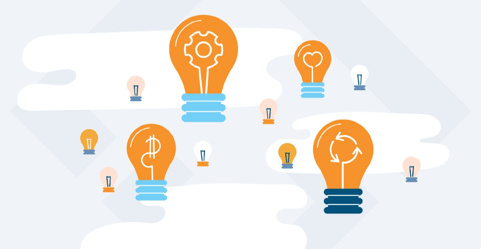How To Avoid Solving The Wrong Customer Problem

Do you ever feel like you’ve done everything you’re supposed to do, but you’re still coming up short in your product innovation efforts? Or do you think you are investing in the wrong product ideas?
New product teams struggle to find the time to talk to customers, and even when they do, they don’t always go deep enough in their research, which can lead them to create the wrong product or feature. By adopting a hypothesis-driven approach to gathering voice of customer data and testing assumptions, your team can optimize their time and effort in creating products that customers will love.
What does it mean to “not go deep enough” in your customer research? Typically, this means your team is either not asking enough “why’s,” or forgetting to validate that the problem is both urgent and expensive.
This often presents through inexperienced researchers accepting the first answer a customer provides as the true problem and not asking the obvious follow-up question, “why is that the case?”
3 Product Traps of Not Going Deep Enough:
Trap #1: Confusing the current solution with the problem. Henry Ford famously said, “If I had asked people what they wanted, they would have said a faster horse!” We hear product teams say this all the time, “well, this is exactly what the customer asked for, and they still aren’t using it.” This is why I urge teams to dig a little deeper. Why did people want faster horses? To get them from point A to point B faster - that is the real problem, not that their horse is too slow.
Trap #2: Addressing a symptom of the problem, not the root cause. This is another situation where product teams take what a customer has said and run toward fixing that problem. A great example of a company that overcame this mistake is Delta Airlines. Even with lower-than-average flight delays, customers were complaining about delays. Instead of taking that information and trying to reduce delays by buying more planes, hiring more staff, etc., they asked another question - “why are delays a problem for you,” and they got some interesting responses. Customers said things like, “it’s frustrating when I have to sit at the airport for so long” and “it makes me anxious not knowing when I will get to my final destination.” instead of trying to reduce their already low rate of flight delays, they opted to solve the root cause problem by sending customers notifications more frequently, earlier and including more information. Now, people can get an early notification about a flight delay and stay home instead of sitting at the airport.
Trap #3: Mistaking a commonly cited problem with an urgent & expensive problem. This happens when researchers forget to validate if a problem is urgent and expensive; for example, maybe getting too many notifications on an app is annoying, but that doesn’t mean there is enough pain that I would pay more to stop getting them.
Vecteris defines an urgent problem as something that a customer needs to solve within the year and an expensive problem as something they are willing to put resources towards solving.
We must understand how big of a problem something is for our buyers and users. Where does it fall in their list of priority problems? How soon do they need to solve this? And would they be willing to pay or dedicate resources to solving this problem?
By adopting a hypothesis-driven approach to gathering voice of customer data and testing assumptions, you can overcome these common mistakes.

What is a hypothesis?
It’s a testable statement or assumption that provides a potential answer to a business question. Simply put, it’s your best guess as to what the answer to a question is. We use this approach for three main reasons:
#1. To help us become more data-driven in our decision-making. If you are just looking for the answer to a question, we risk accepting the first answer and moving on. With a hypothesis, you need to validate if that answer is true or false. This forces the researcher to push towards understanding why the answer was given.
#2. To foster healthy team discussions. How often have you been in a meeting where two people think there are different answers to a question? With a hypothesis-driven approach, everything discussed is a hypothesis that needs to be tested with the market. What that means for meetings is a healthy discussion about all the possibilities without the team having to decide who is right or wrong. If both opinions are collected as hypotheses, validated with the market and supporting evidence, the conversation can move forward efficiently.
#3 Focus your research on where it will be the most impactful. Product teams have a lot on their plate, so we need to use hypotheses to prioritize the things that are critical or riskiest before moving to the next step. Take Rent the Runway, for example. When they were getting started, they had a few critical hypotheses, such as:
“People will rent dresses that others have previously worn” and
People will rent dresses without being able to try them on first.”
They needed to test hypotheses like these first because they were riskier than things like “People will rent black dresses more frequently than other dresses’. Creating hypotheses allows you to focus your research, so you don’t have to get answers to every question all at once.
With hypothesis-driven research, we give our product teams a better chance of success.
So remember, before going into a customer research interview:
- Create hypotheses for what you need to learn
- Prioritize your hypothesis list based on things that are riskiest or most critical to the next step in your research.
- Create an interview guide to help you keep your conversation on track and ensure you have questions to test each of your high-priority hypotheses.
- Don’t be afraid to ask the 5 whys to get you to the root cause of the problem.
- Make sure you validate if something is both urgent and expensive.
- You understand the urgency drivers, and if they are willing to dedicate money and resources to solving the problem.

Need additional help with your voice-of-customer (VoC) research?
Vecteris specializes in VoC research. We include problem-framing, solution design, messaging/positioning, win/loss, and more. Your organization will gain insights to guide marketing and product development in key stages, as well as a clear understanding of your customers' urgent and expensive problems early in the development process, allowing you to design features around your buyers and users.
The external perspective Vecteris provides helps stakeholders prioritize investment and resource allocation decisions around products and features. If your company needs guidance on collecting Voice of the Customer research, please reach out.
